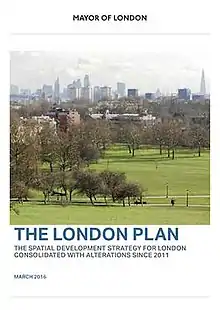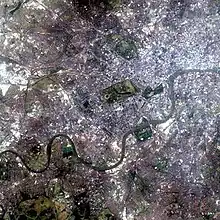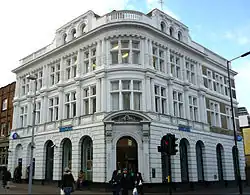London Plan
The London Plan is the statutory spatial development strategy for the Greater London area in the United Kingdom that is written by the Mayor of London and published by the Greater London Authority. It is updated from time to time.[2]
 Cover of the 2016 London Plan | |
| Author | Mayor of London |
|---|---|
| Country | England and United Kingdom |
| Language | English |
| Subject | Statutory planning document of Greater London |
| Publisher | Greater London Authority |
Publication date | March 2021[1] |
| Media type | Digital (online and PDF) |
| This article is part of a series within the Politics of England on the |
| Politics of London |
|---|
 |
The regional planning document was first published in final form on 10 February 2004. In addition to minor alterations, it was substantially revised and republished in February 2008 and July 2011. In October 2013, minor alterations were made to the plan to comply with the National Planning Policy Framework and other changes in national policy.[3]
The London Plan of March 2016 was published, and amended in January 2017 (for typsetting corrections), with a formal end-date of 2036.
In March 2021 a new London Plan was adopted by the Greater London Authority, planning for the next 20–25 years.
Mandate
The plan replaced the previous strategic planning guidance, or Regional Planning Guidance (RPG), for London issued by the Secretary of State and known as RPG3.[4] It is a requirement of the Greater London Authority Act 1999 that the document is produced and that it deals only with matters that are of strategic importance to Greater London. The Act also requires that the London Plan includes in its scope:
- the health of Londoners,
- equality of opportunity,
- contribution to sustainable development in the United Kingdom.
Objectives
The plan is a spatial development strategy for the Greater London area and has six objectives.
The original 2004 objectives were:
- To accommodate London's growth within its boundaries without encroaching on open spaces
- To make London a better city for people to live in
- To make London a more prosperous city with strong and diverse economic growth
- To promote social inclusion and tackle deprivation and discrimination
- To improve London's accessibility
- To make London a more attractive, well-designed and green city
— London Plan, 2004
The objectives were updated in 2008 following the Greater London Authority Act 2007:
- To accommodate London's growth within its boundaries without encroaching on open spaces
- To make London a healthier and better city for people to live in
- To make London a more prosperous city with strong and diverse long term economic growth
- To promote social inclusion and tackle deprivation and discrimination
- To improve London's accessibility
- To make London an exemplary world city in mitigating and adapting to climate change and a more attractive, well-designed and green city
— London Plan, 2008
The objectives as adopted by the 2011 and 2016 revisions, are to ensure that London is:
- a city that meets the challenges of economic and population growth
- an internationally competitive and successful city
- a city of diverse, strong, secure and accessible neighbourhoods
- a city that delights the senses
- a city that becomes a world leader in improving the environment
- a city where it is easy, safe and convenient for everyone to access jobs, opportunities and facilities
— London Plan, 2011 and 2016
Policies

The 2016 plan had chapters:
| Chapter | Title | Summary |
|---|---|---|
| 1 | Context and strategy | Demography, external forces, quality of life |
| 2 | Places | Sub-regions, Outer London, Inner London, Central Activities Zone, opportunity areas, intensification areas, town centres |
| 3 | People | Health, housing, social infrastructure |
| 4 | Economy | Economic sectors and workspaces |
| 5 | Response to climate change | Climate change mitigation, climate change adaptation, waste, contaminated land |
| 6 | Transport | Integrating transport and development, connectivity |
| 7 | Living spaces and places | Place shaping, environment and landscapes, air and noise pollution, emergency planning, Blue Ribbon Network |
| 8 | Implementation, monitoring, and review | |
| Annexes | One to six |
Opportunity areas
The plan identifies dozens of areas of opportunity, which are where the bulk of efforts will be concentrated, with an aim at reducing social deprivation and creating sustainable development. The opportunity areas will be able to accommodate around 5,000 jobs each or about 2,500 homes, or a mixture of the two. The opportunity areas will mostly be town centres as opposed to suburban developments in the boroughs, although those are mentioned as important in terms of job growth and quality of life. By definition, an Opportunity Area is brownfield land with significant capacity for development. This contrasts with an Intensification Area that can be developed to higher than existing densities with more modest economic change.[5]
Sub-regions

For the purposes of the plan, London is divided into five sub-regions. From 2004 to 2008 the sub-regions were initially the same as the Learning and Skills Council areas established in 1999.[6] Within this scheme there was a separate Central sub-region and four others around it. The London part of the Thames Gateway zone was entirely contained within the East London sub-region. The 2004–08 sub-regions each had a Sub-Regional Development Framework.[7]
The sub-regions were revised in February 2008 as part of the Further Alterations to the London Plan. These sub-regions each radiated from the centre to combine inner and outer London boroughs.[8] The 2008–11 sub-regions, each had its own Sub Regional Implementation Framework.[9]
In 2011 the sub-regions were revised again. A smaller Central sub-region was reintroduced, the South sub-region was reintroduced, and all boroughs in the Thames Gateway were returned to the East sub-region.[10] The 2011 sub-regions are maintained in the 2016 London Plan.[11]
Throughout these revisions has been a separately defined Central Activities Zone which includes areas with a very high concentration of metropolitan activities.
Activity centres

The London Plan identifies 201 activity centres in the city. All activity centres are categorised into:
- 2 international centres, the West End and Knightsbridge.
- 14 metropolitan centres such as Hounslow, Bromley, Ealing, Stratford and Wood Green
- 36 major centres such as Brixton, Dalston, Eltham and Kilburn
- 149 district centres such as Camberwell, West Hampstead and Whitechapel.
Smaller local and neighbourhood centres are also referred to in the plan but are not listed.
Alterations
There have been a number of amendments to the London Plan which have been incorporated into the current version that was published in February 2008. Early alterations were made covering housing provision targets, waste and minerals. Further alterations to the plan covered climate change; London as a world city; The London Economy; Housing; Tackling social exclusion; Transport; London's geography, the sub-regions and inter-regions; Outer London; Liveability (including safety, security and open spaces); and the 2012 Olympic Games and Paralympic Games. The mayor gained new statutory powers following the Greater London Authority Act 2007.
Following the 2008 change of mayor, a new review was initiated in July 2008 and a new London Plan published in July 2011. As of this date, modifications are made to fully comply with the National Planning Policy Framework.
In 2013, London Mayor Boris Johnson proposed early minor alterations to the London Plan that were aimed at preventing boroughs from setting rent caps or targets for affordable rented homes in their local development frameworks.[12] The alterations were approved in a vote by the London Assembly in September 2013.[13]
Alterations made since July 2011 were consolidated in the London Plan of March 2016, which re-published with typsetting corrections in January 2017.
Following the 2016 change of mayor, London Mayor Sadiq Khan outlined proposals towards creating a new London Plan.[14] A draft version was published in December 2017, with the final version formally coming into effect on 2 March 2021.[15]
| Date | Document |
|---|---|
| February 2004 | The London Plan 2004[lower-alpha 1][16] |
| October 2005 | Draft Alterations to the London Plan: Housing Provision Targets Waste and Minerals |
| December 2005 | Reviewing the London Plan: Statement of Intent from the Mayor |
| September 2006 | Draft Further Alterations to the London Plan |
| December 2006 | Early Alterations to the London Plan on Housing provision targets, waste and minerals |
| February 2008 | The London Plan 2008[lower-alpha 1][17] |
| July 2008 | Planning for a better London |
| April 2009 | A new plan for London: Proposals for the Mayor's London Plan |
| October 2009 | The London Plan: Consultation draft replacement plan |
| December 2009 | Minor alteration to the consultation draft replacement London Plan |
| April 2010 | Crossrail Alterations |
| July 2011 | The London Plan 2011[lower-alpha 1][18][19] |
| February 2012 | Early Minor Alterations to the London Plan |
| October 2013 | Revised Early Minor Alterations to the London Plan |
| March 2015 | Further Alterations to the London Plan |
| March 2016 (typsetting corrections January 2017) |
The London Plan 2016[lower-alpha 1][20] |
| December 2017 | Draft version of the updated London Plan released for consultation |
| August 2018 | Minor changes published |
| March 2021 | The London Plan 2021[lower-alpha 1][1] |
- Short title.
References
- Khan, Sadiq (Mayor of London) (March 2021). The London Plan - The Spatial Development Strategy for Greater London (PDF). London: Greater London Authority. ISBN 978-1-84781-739-6. Archived (PDF) from the original on 25 May 2023. Retrieved 6 September 2023.
- "The London Plan, Web page". London City Hall. 8 June 2023.
- Mayor of London (October 2013). "REMA". London Assembly. Retrieved 1 May 2017.
- "Strategic Guidance for London Planning Authorities" (PDF). regulations.completepicture.co.uk.
- "What are Opportunity Areas?". London Plan. Greater London Authority. 20 November 2015. Retrieved 10 February 2017.
- Addison & Associates (June 2006). "Review of London's Sub Regional Boundaries" (PDF). Greater London Authority. Archived from the original (PDF) on 4 June 2011.
- Mayor of London (May 2006). "Sub Regional Development Frameworks". Greater London Authority. Archived from the original on 9 November 2008.
- Mayor of London (February 2008). "The London Plan: Sub-regions, CAZ and government growth area policies". Greater London Authority. Archived from the original on 13 July 2009.
- Mayor of London (September 2006). "Draft Further Alterations to the London Plan" (PDF). Greater London Authority. Archived from the original (PDF) on 4 June 2011.
- Mayor of London (March 2016). "London Plan 2016, Chapter 2" (PDF). London Assembly. Retrieved 1 May 2017.
- Mayor of London (March 2016). "London Plan 2016, Chapter 2". London Assembly. Retrieved 1 May 2017.
- Labour group fails in bid to block London Plan revisions. Planning Resource (4 September 2013). Retrieved on 6 December 2013.
- Mayor could face legal challenge to London Plan alterations. Out-law.com. Retrieved on 6 December 2013.
- Mayor outlines plans to create 'A City for all Londoners'. london.gov.uk. Retrieved on 1 May 2017.
- London Plan 2021 - Planning (Presentation) (PDF) (Report). Mayor of London. March 2021. p. 12.
- Livingstone, Ken (Mayor of London) (February 2004). The London Plan - Spatial Development Strategy for Greater London. London: Greater London Authority. ISBN 1-85261-544-3. Archived from the original on 6 September 2023. Retrieved 6 September 2023.
- Livingstone, Ken (Mayor of London) (February 2008). The London Plan - Spatial Development Strategy for Greater London - Consolidated with Alterations since 2004. London: Greater London Authority. ISBN 978-1-84781-129-5. Archived from the original on 25 June 2023. Retrieved 6 September 2023.
- Johnson, Boris (Mayor of London) (July 2011). "Cover / Contents / Mayor's Forward / Overview and Introduction". The London Plan - Spatial Development Strategy for Greater London. London: Greater London Authority. pp. Front cover–14. ISBN 978-1-84781-451-7. Archived from the original on 6 September 2023. Retrieved 6 September 2023.
- "London Plan 2011". Greater London Authority. July 2011. Archived from the original on 27 June 2023. Retrieved 6 September 2023.
[web portal to chapter documents, per:] The Mayor published the replacement London Plan in July 2011. It is available to download by chapter below.
- Johnson, Boris (Mayor of London) (March 2016). The London Plan - The Spatial Development Strategy for London - Consolidated with Alterations Since 2011 (PDF) (January 2017 (typsetting corrections) ed.). London: Greater London Authority. Archived (PDF) from the original on 2 July 2023. Retrieved 6 September 2023.
External links
- The London Plan on the Greater London Authority's Web site
- Outer London Commission – established by Mayor "to advise how Outer London can play its full part in the city's economic success" (2009)
